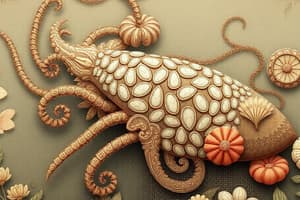Podcast
Questions and Answers
What type of cavity do Mollusks have?
What type of cavity do Mollusks have?
They are coelomates.
What type of symmetry do Mollusks have?
What type of symmetry do Mollusks have?
They have bilateral symmetry.
What type of body do Mollusks have?
What type of body do Mollusks have?
They have a soft internal body.
What type of digestive system do Mollusks have?
What type of digestive system do Mollusks have?
What's a mantle in Mollusks?
What's a mantle in Mollusks?
What are some animals that belong to the Mollusks?
What are some animals that belong to the Mollusks?
How do Mollusks feed (specifically snails)?
How do Mollusks feed (specifically snails)?
What type of internal body do Mollusks have?
What type of internal body do Mollusks have?
What are gills and what do they do in Mollusks?
What are gills and what do they do in Mollusks?
What is an open circulatory system in Mollusks?
What is an open circulatory system in Mollusks?
What is a closed circulatory system?
What is a closed circulatory system?
How do Mollusks get rid of wastes?
How do Mollusks get rid of wastes?
How do Mollusks respond to stimuli?
How do Mollusks respond to stimuli?
How do Mollusks reproduce?
How do Mollusks reproduce?
What is the class Gastropod?
What is the class Gastropod?
What is the class Bivalves?
What is the class Bivalves?
What is the class Cephalopods?
What is the class Cephalopods?
What are some methods of Cephalopod protection?
What are some methods of Cephalopod protection?
Flashcards are hidden until you start studying
Study Notes
Mollusks Overview
- Mollusks are coelomates, meaning they possess a true coelomic cavity.
- They exhibit bilateral symmetry, which is a characteristic body plan seen in many animals.
Body Structure and Systems
- Mollusks have soft internal bodies with specialized anatomical features.
- Their digestive system includes a complete tract with two openings, facilitating efficient digestion.
- The mantle, a key anatomical feature, covers the organs of digestion, acting as a protective layer.
Types of Mollusks
- Common examples include mussels, clams, snails, octopuses, and squids.
- The class Gastropod is the largest, primarily featuring animals with a single shell like snails and conches, while slugs lack shells.
- Bivalves have two shells and include species like clams, mussels, oysters, and scallops; they use a muscular foot for locomotion.
- Cephalopods are head-footed mollusks with arms and tentacles equipped with suckers, including squids, octopuses, and cuttlefish.
Feeding and Digestion
- Mollusks feed using a radula, a specialized structure that scrapes food into their mouths.
- They have complete digestive systems, consisting of digestive glands, stomachs, and intestines, designed for effective nutrient absorption.
Respiration and Circulation
- Gills, located within the mantle, are essential for respiration, facilitating the exchange of oxygen and carbon dioxide.
- Mollusks often possess an open circulatory system, where blood circulates through open spaces, diffusing oxygen and nutrients directly into tissues.
Waste Excretion and Response
- Waste is excreted via nephridia, which handle waste disposal from cellular processes.
- Mollusks exhibit nervous systems that coordinate their movements and responses to environmental stimuli.
Reproduction
- They primarily reproduce sexually, sharing common developmental patterns across different species.
Defensive Mechanisms in Cephalopods
- Cephalopods have developed various protective strategies, such as expelling water to escape threats, hiding, releasing ink for concealment, and changing color to blend into their environment.
Studying That Suits You
Use AI to generate personalized quizzes and flashcards to suit your learning preferences.




